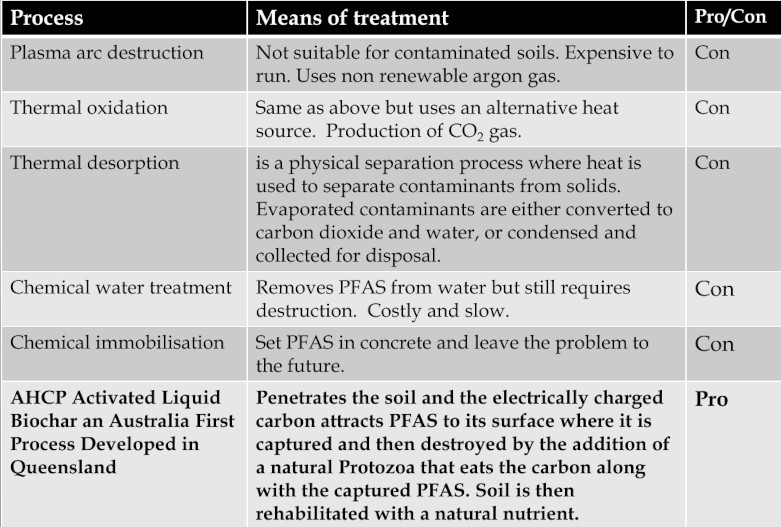Introduction to AHCP and the PFAS Destroying Technology
Robert Tonks, an Engineer in Queensland Australia, designed and developed a portable containerized pyrolysis machine to produce activated carbon BioChar. In an Australian first process, Robert developed a way to produce activated liquid Biochar that destroys toxic PFAS chemicals in soil with a three step process. Independently tested and verified by Australia’s CSIRO and ALS, who are a globally accredited testing Group.
AHCP and CSIRO Collaborative Test Results Showing Reduction of all forms of PFAS

AHCP Cost Effective Soil Remediation
AHCP uses its unique activated BioChar liquid carbon and natural microbial (live culture) solutions developed and named Combat and Rehab, to treat
contaminated soil. There is also great potential to treat contaminated water as well. These microbes cannot persist in the environment after they have destroyed PFAS due to their food needs which are not present in soils after PFAS..
AHCP’s unique treatment does not take many months or years to complete and is done on site. No need for excavation and transportation of hazardous soil to potentially pollute another site. A costly process.
After destroying PFAS the process adds nutrients to the treated soil in the form of organic matter, being the microbe bodies.
Per-and poly-fluoroalkyl substances, also known as PFAS
A group of man-made chemicals that are resistant to heat, water, and oil. Hence they persist.
Although manufacturers have since phased out the use of PFAS in many consumer products, they are still used in some industrial and specialty applications including:
- certain types of fire-fighting foams
- metal plating and plastics etching
- photo-imaging applications
- aviation hydraulic fluid
- in the manufacture of some non-stick cookware
- fabric, furniture and stain protection applications
- some food packaging
Why is PFAS a Concern?
- Australia as well as most other countries consider the release of PFAS into the environment as a significant concern because PFAS:
- is highly persistent
- can move long distances in the environment
- have been shown to be toxic to fish and some animals and humans
What does PFAS do to your body?
A growing chorus of science has found that there are potential adverse health impacts associated with PFAS exposure, including liver damage, thyroid disease, decreased fertility, high cholesterol, obesity, hormone suppression and cancer.
Present PFAS treatment methods

What is the cost of doing nothing about toxic PFAS with a solution available
- Degraded toxic environment for possibly centuries to come.
Health of humans, animals, wildlife, aquatic life and degraded agricultural opportunity. - Subterranean water pollution. Toxic chemical leaching “downstream” to yet to be discovered sites of environmental and health concern
- Leaving the problem for future generations
There is a Tested and Documented Solution to Help Resolve the PFAS problem using AHCP Technology
- What is the responsible way forward now?
- It is Your Choice to make a difference.
- Email: contact@ecoactivechar.com.au
- Robert Tonks-Engineer: 0421369704
- John Oweczkin-Analytical Chemist: 0427237378
- Kevin Driscoll-BDM: 0428086118

